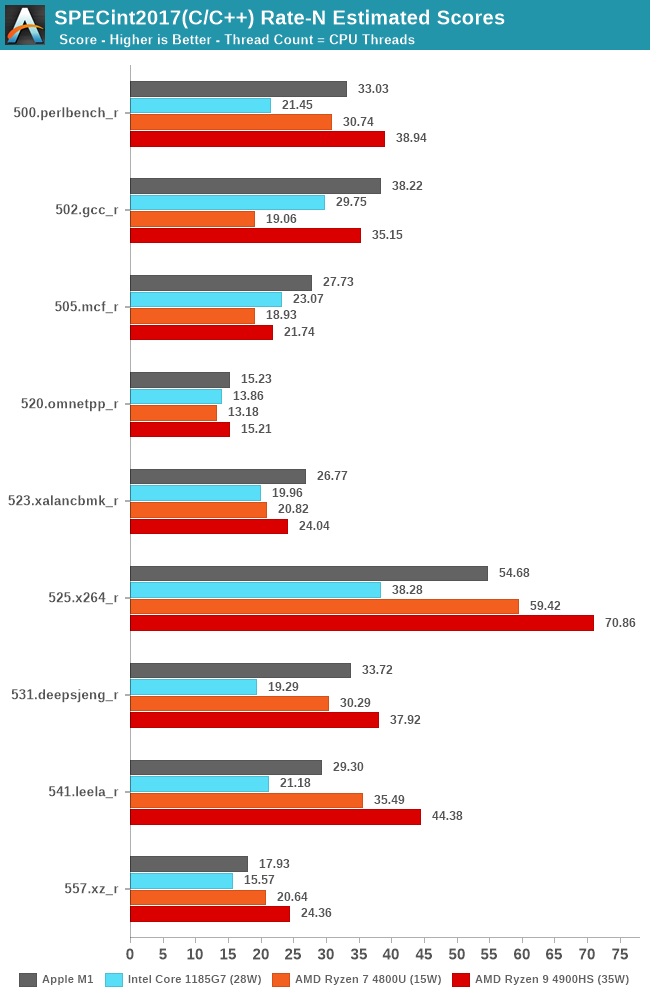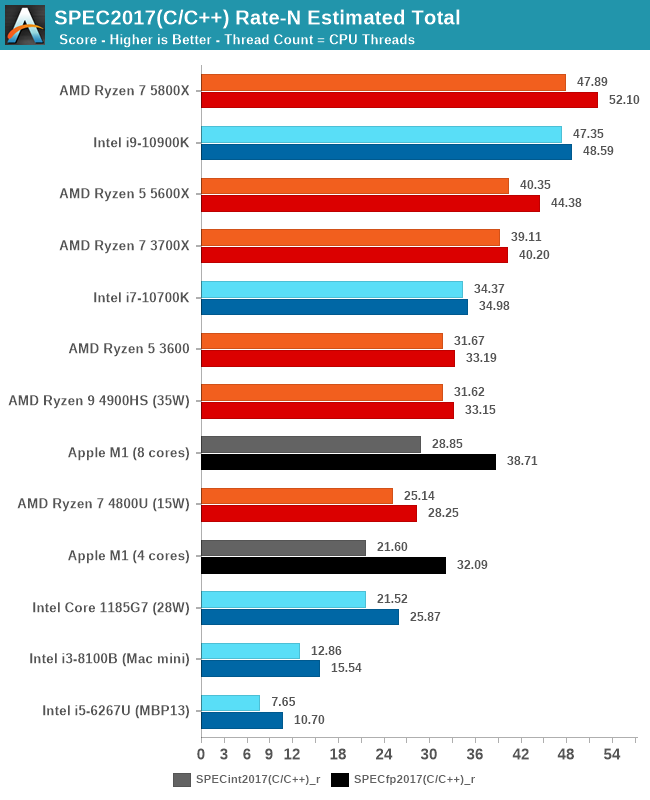The 2020 Mac Mini Unleashed: Putting Apple Silicon M1 To The Test
by Andrei Frumusanu on November 17, 2020 9:00 AM ESTSPEC2017 - Multi-Core Performance
While we knew that the Apple M1 would do extremely well in single-threaded performance, the design’s strengths are also in its power-efficiency which should directly translate to exceptionally good multi-threaded performance in power limited designs. We noted that although Apple doesn’t really publish any TDP figure, we estimate that the M1 here in the Mac mini behaves like a 20-24W TDP chip.
We’re including Intel’s newest Tiger Lake system with an i7-1185G7 at 28W, an AMD Ryzen 7 4800U at 15W, and a Ryzen 9 4900HS at 35W as comparison points. It’s to be noted that the actual power consumption of these devices should exceed that of their advertised TDPs, as it doesn’t account for DRAM or VRMs.

In SPECint2017 rate, the Apple M1 battles with AMD’s chipsets, with the results differing depending on the workload, sometimes winning, sometimes losing.

In the fp2017 rate results, we see similar results, with the Apple M1 battling it out with AMD’s higher-end laptop chip, able to beat the lower TDP part and clearly stay ahead of Intel’s design.

In the overall multi-core scores, the Apple M1 is extremely impressive. On integer workloads, it still seems that AMD’s more recent Renoir-based designs beat the M1 in performance, but only in the integer workloads and at a notably higher TDP and power consumption.
Apple’s lead against Intel’s Tiger Lake SoC at 28W here is indisputable, and shows the reason as to why Apple chose to abandon their long-term silicon partner of 15 years. The M1 not only beats the best Intel has to offer in this market-segment, but does so at less power.
I also included multi-threaded scores of the M1 when ignoring the 4 efficiency cores of the system. Here although it’s an “8-core” design, the heterogeneous nature of the CPUs means that performance is lop-sided towards the big cores. That doesn’t mean that the efficiency cores are absolutely weak: Using them still increases total throughput by 20-33%, depending on the workload, favouring compute-heavy tasks.
Overall, Apple doesn’t just deliver a viable silicon alternative to AMD and Intel, but actually something that’s well outperforms them both in absolute performance as well as power efficiency. Naturally, in higher power-level, higher-core count systems, the M1 can’t keep up to AMD and Intel designs, but that’s something Apple likely will want to address with subsequent designs in that category over the next 2 years.










682 Comments
View All Comments
Spunjji - Thursday, November 19, 2020 - link
Agreed with both of you, here. It seems that ARM have likely taken some of Apple's design principles into account with the X1, and with any luck future iterations on that design will close the gap.Kishoreshack - Tuesday, November 17, 2020 - link
People are saying apple have smashed intel & AMDThe only question is how?
ElvenLemming - Tuesday, November 17, 2020 - link
5nm process node and an extremely wide pipeline design that's much harder to implement in x86.tipoo - Tuesday, November 17, 2020 - link
Look at the 630 entry deep ROB, the cache specs, or the front end decode or the back end width. It's a wildly ambitious core and they were not afraid to go very big.StormyParis - Tuesday, November 17, 2020 - link
Thank you, especially for including modern, competitive x86 CPUs and not just the relatively outdated ones in current x86 Macs.I've looked at the new MacBook Air, it's the same price and speed as a core i7 (IIRC) Dell XPS 13, so it comes down to battery life and silence vs RAM and storage expandability, ports, software compatibility, and peripherals compatibility. But not really a game changer ?
ingwe - Tuesday, November 17, 2020 - link
I'd say that on the power consumption side it is a game-changer. I would expect their next gen to be even better. I am actually considering an Air now and I thought I would be getting an XPS 13 for my next machine.YesYesNo - Tuesday, November 17, 2020 - link
If dell start using AMD already the xps 15 will be my next work laptop. I'm not holding my breath though.Spunjji - Thursday, November 19, 2020 - link
Same here on both counts. An XPS 15 with Cezanne and an RDNA 2 GPU would be the bomb; I doubt it's going to happen, though.misan - Tuesday, November 17, 2020 - link
It’s faster and cheaper than XPS 13 and it has better battery.taligentia - Tuesday, November 17, 2020 - link
20 hours battery life with incredible performance is a game changer.